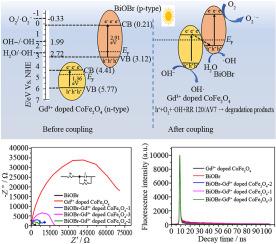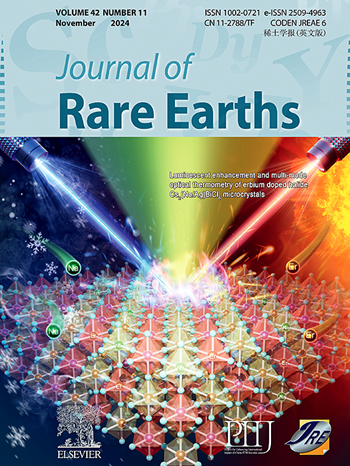Gd3+掺杂CoFe2O4偶联氧化溴化铋在可见光下去除有机污染物:活性红120和酸性紫7及其机理
IF 7.2
1区 化学
Q1 CHEMISTRY, APPLIED
引用次数: 0
摘要
本研究采用化学沉淀法制备了一种新型的磁性bibr - gd3 +掺杂CoFe2O4纳米复合材料,用于酸性紫7 (AV 7)和活性红120 (RR 120)染料在阳光下的降解。采用x射线衍射(XRD)、x射线光电子能谱(XPS)、透射电子显微镜(TEM)、扫描电子显微镜(SEM)、能量色散x射线分析(EDAX)、紫外-可见近红外(NIR)、光致发光(PL)、TRF、EIS、Mott-Schottky和BET分析对样品进行了表征。bibr -Gd3+掺杂CoFe2O4纳米复合材料的x射线衍射图证实了bibr -Gd3+掺杂CoFe2O4样品的衍射峰组成的复合材料的形成。利用光致发光(PL)、时间分辨荧光光谱(TRF)和电化学阻抗谱(EIS)研究了光诱导载流子的转移效率。在所合成的材料中,bibr - gd3 +掺杂的CoFe2O4-2纳米复合材料对rs120的降解率为87.34%,对av7的降解率为98.41%。av7的表观速率常数(k)值为0.1317 min−1,是原始BiOBr的16倍,RR 120 (0.0135 min−1)是原始BiOBr的2倍。自由基捕获实验也证明了光生成的h+、O2·−和·OH自由基在降解机制中的作用。bibr - gd3 +掺杂CoFe2O4-2的优异性能归因于异质结构的形成、内置电场和能带对准,这在热力学和动力学上有利于异质结的光活性和稳定性。本文章由计算机程序翻译,如有差异,请以英文原文为准。

Gd3+ doped CoFe2O4 coupled with bismuth oxybromide for visible-light-driven removal of organic contaminants: Reactive Red 120 and Acid Violet 7 and its mechanism insights
In the current study novel magnetic BiOBr-Gd3+ doped CoFe2O4 heterojunction nanocomposites fabricated by chemical precipitation method for Acid Violet 7 (AV 7) and Reactive Red 120 (RR 120) dye degradation under sunlight are presented. The samples were well characterized by X-ray diffraction (XRD), X-ray photoelectron spectroscopy (XPS), transmission electron microscopy (TEM), scanning electron microscopy (SEM), energy dispersive X-ray analysis (EDAX), UV–visible near infrared (NIR), photoluminescence (PL), TRF, EIS, Mott–Schottky, and BET analysis. X-ray diffractograms of BiOBr-Gd3+ doped CoFe2O4 nanocomposites authenticate the formation of the composite composed of diffraction peaks of both BiOBr and Gd3+ doped CoFe2O4 samples. Photoluminescence (PL), Time Resolved Fluorescence Spectrocopy (TRF) and Electrochemical Impedance Spectroscopy (EIS) investigations were explored to examine the transfer efficiency of photoinduced charge carriers. Among the synthesized materials, the BiOBr-Gd3+ doped CoFe2O4-2 nanocomposite presents superior degradation capability for RR 120 of 87.34% and AV 7 dyes of 98.41%. The apparent rate constant (k) value of 0.1317 min−1 for AV 7 is sixteen times higher and RR 120 (0.0135 min−1) is 2 times higher than pristine BiOBr. The radical trapping experiments also proved the role of photogenerated h+, O2·−, and ·OH radicals in the degradation mechanism. The superior performance of BiOBr-Gd3+ doped CoFe2O4-2 is ascribed to the formation of the heterostructure, the in-built electric field, and energy-band alignment, which thermodynamically and kinetically favors the photoactivity and stability of the heterojunction.
求助全文
通过发布文献求助,成功后即可免费获取论文全文。
去求助
来源期刊

Journal of Rare Earths
化学-应用化学
CiteScore
8.70
自引率
14.30%
发文量
374
审稿时长
1.7 months
期刊介绍:
The Journal of Rare Earths reports studies on the 17 rare earth elements. It is a unique English-language learned journal that publishes works on various aspects of basic theory and applied science in the field of rare earths (RE). The journal accepts original high-quality original research papers and review articles with inventive content, and complete experimental data. It represents high academic standards and new progress in the RE field. Due to the advantage of abundant RE resources of China, the research on RE develops very actively, and papers on the latest progress in this field emerge every year. It is not only an important resource in which technicians publish and obtain their latest research results on RE, but also an important way of reflecting the updated progress in RE research field.
The Journal of Rare Earths covers all research and application of RE rare earths including spectroscopy, luminescence and phosphors, rare earth catalysis, magnetism and magnetic materials, advanced rare earth materials, RE chemistry & hydrometallurgy, RE metallography & pyrometallurgy, RE new materials, RE solid state physics & solid state chemistry, rare earth applications, RE analysis & test, RE geology & ore dressing, etc.
 求助内容:
求助内容: 应助结果提醒方式:
应助结果提醒方式:


